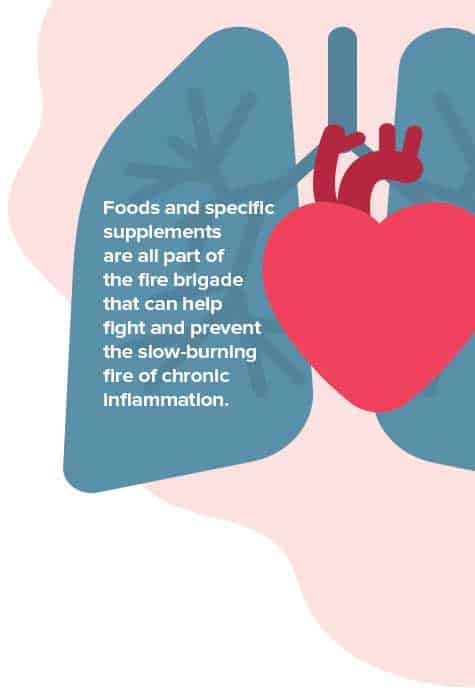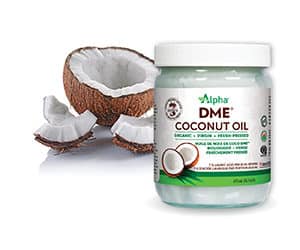

Most of us are familiar with the outward signs that accompany an acute injury: swelling, redness, and warmth – all common symptoms of acute inflammation. Within a few days or weeks, the healing process is usually complete, depending on the nature or the severity of the injury.
Chronic inflammation is entirely another matter! It is most often silent and is fuelled continuously by inflammatory mediators causing systemic inflammation in the organs and tissues. In most cases, we are completely unaware of this slow-burning fire. Stopping the runaway fire is often difficult because the immune system’s fire brigade gets tired and cannot prevent tissue damage and progression towards disease.
Although there may not be a single path to disease, mounting evidence suggests inflammation is a common underlying cause of most chronic diseases including diabetes, obesity, autoimmune disease, cardiovascular disease, cancer, inflammatory bowel disease, chronic respiratory diseases, asthma, mental health disorders such as depression, anxiety, and neurodegenerative diseases such as Alzheimer’s.
Many factors can cause chronic inflammation. Most of these factors you have control over while others you don’t.
Many of these adverse health effects can be prevented by avoiding inflammatory foods, and using herbs and supplements that protect from the ravages of inflammation.
- AGING – a chronic pro-inflammatory state is common in aging
- STRESS – in chronic stress, the adrenal glands secrete high levels of cortisol which affect metabolism, insulin levels, the immune system, and chronic inflammation
- DIETARY CHOICES – diets high in sugar, trans fats (hydrogenated oils), saturated fats, refined and processed foods, all lead to inflammation
- GLUTEN in breads and crackers, and casein in dairy products can be a problem for susceptible people
- FOOD ADDITIVES such as MSG – read labels carefully
- CIGARETTE SMOKE, AIR POLLUTION, AND SMOKE FROM LOCAL FOREST FIRES can contribute to inflammation
- TOXIC EXPOSURE from our foods, water, building environment, heavy metals, and pesticides, have a negative impact on your immune system and promote inflammation
- CHRONIC INSOMNIA can elevate pro-inflammatory factors
- DEHYDRATION leads to increased inflammation – drink at least 1.5 L of filtered water daily
In Canada and the United States, many areas of each country are experiencing unprecedented forest fires causing poor air quality levels that are incredibly harmful. The smoke irritation in the lungs and toxic particulate matter in the air is causing lung inflammation, particularly harmful to the young, elderly, and anyone with compromised lung function. For those who live in areas susceptible to forest fires, be proactive and protect your lungs from some of the devastating health effects of toxic smoke. Although air pollution is well known to be harmful to the lungs and respiratory system, it can also damage most other organs in the body. New research shows air pollution is associated with heart and lung disease, diabetes, dementia, liver problems, bladder cancer, childhood leukemia, osteoporosis, damaged skin, autoimmunity, allergies, infertility, harm to fetus, mental and physical development delays in children, and more. The systemic damage is the result of particulate matter and pollutants causing oxidative stress and inflammation throughout the body. Air pollution is a bigger killer than tobacco smoking and is associated with: 500,000 lung cancer deaths 1.6 million COPD deaths 19% of all cardiovascular deaths 21% of all stroke deaths In the bigger picture, there needs to be greater awareness and efforts made to do all we can to minimize air pollution and other toxic exposures that have such negative effects on the health of people of all ages.
Air pollution is a “public health emergency”, according to the World Health Organization, with more than 90% of the global population enduring toxic outdoor air.
AIR POLLUTION EFFECTS
- Can cause strokes – ultrafine particles have been found in samples of brain and central nervous system tissue
- Can affect thinking skills (cognition) in older people
- Can make asthma worse
- Can make existing heart conditions worse
- Air pollution is linked to the development of stroke and heart disease, including atherosclerosis
- Air pollution increases the risk of lung cancer
- Ultrafine particles have been found in reproductive organs and in unborn children
AIR POLLUTION EFFECTS ON CHILDREN
- The brain can be damaged by air pollution
- Causes more children to be admitted to hospital with respiratory illness
- Affects normal lung development, causing lifelong problems
- Increases coughing and wheezing
- Makes asthma worse
- The heart, hormone systems, and immunity can all be harmed by air pollution
ANTI-INFLAMMATORY SUPPLEMENTS
OMEGA-3
Fight fire with oils, not water. Cannabinoids made from omega-3 fatty acids can help fight inflammation.
What is the endocannabinoid system (ECS)? The ECS regulates an array of physiological processes through different receptors in the body configured to accept cannabinoids, including endocannabinoids (within the body) and phytocannabinoids in plants such as cannabis (marijuana or hemp). When cannabinoids bind to various receptors, they elicit an anti-inflammatory and anti-pain action. Cannabinoids synthesized from omega-3 fatty acids DO NOT produce a “high”, like the cannabinoid tetrahydrocannabinol (THC) in marijuana. The cannabis plant was thought to be the only cannabinoid that affected these specific receptors, but research shows that other plants and foods, including omega-3 fatty acids, can also help modulate and nourish the ECS. Scientists have discovered that the body converts the omega-3 derived endocannabinoids into anti-inflammatory molecules that are as potent as THC – but without the “high.” The metabolites from omega-3 are comparable to endocannabinoids, because they provide the same beneficial cardiovascular, neurological, and overall anti-inflammatory health effects.
CURCUMIN
Curcumin has protective effects through its antioxidant response mechanisms that reduce oxidative damage and inflammation caused by particulate matter and toxins in air pollution. It is the yellow pigment in turmeric with many valued health benefits, but curcumin itself is difficult for the body to absorb. Theracurmin is a natural curcumin preparation that utilizes advanced techniques to reduce curcumin’s particle size which dramatically increases its solubility and bioavailability.
N-ACETYL-CYSTEINE
N-acetyl-cysteine or NAC is another powerful firefighter gaining attention for the treatment of inflammatory disorders. Chronic obstructive pulmonary disease (COPD), which includes bronchitis and emphysema, is a rapidly growing problem because of years of oxidative damage to lung tissue, resulting in chronic inflammatory conditions. The disease is worsened by air pollution and cigarette smoking, but is by no means limited to people with those exposures. With its ability to reduce oxidative stress and prevent chronic inflammatory changes, research is showing that NAC is emerging as a game-changing natural therapy in COPD and other respiratory conditions.

ANTI-INFLAMMATORY SUPPLEMENTS
Powerhouse Firefighters
OMEGA-3
Fight fire with oils, not water. Cannabinoids made from omega-3 fatty acids can help fight inflammation.
What is the endocannabinoid system (ECS)? The ECS regulates an array of physiological processes through different receptors in the body configured to accept cannabinoids, including endocannabinoids (within the body) and phytocannabinoids in plants such as cannabis (marijuana or hemp). When cannabinoids bind to various receptors, they elicit an anti-inflammatory and anti-pain action. Cannabinoids synthesized from omega-3 fatty acids DO NOT produce a “high”, like the cannabinoid tetrahydrocannabinol (THC) in marijuana. The cannabis plant was thought to be the only cannabinoid that affected these specific receptors, but research shows that other plants and foods, including omega-3 fatty acids, can also help modulate and nourish the ECS. Scientists have discovered that the body converts the omega-3 derived endocannabinoids into anti-inflammatory molecules that are as potent as THC – but without the “high.” The metabolites from omega-3 are comparable to endocannabinoids, because they provide the same beneficial cardiovascular, neurological, and overall anti-inflammatory health effects.
CURCUMIN
Curcumin has protective effects through its antioxidant response mechanisms that reduce oxidative damage and inflammation caused by particulate matter and toxins in air pollution. It is the yellow pigment in turmeric with many valued health benefits, but curcumin itself is difficult for the body to absorb. Theracurmin is a natural curcumin preparation that utilizes advanced techniques to reduce curcumin’s particle size which dramatically increases its solubility and bioavailability.
N-ACETYL-CYSTEINE
N-acetyl-cysteine or NAC is another powerful firefighter gaining attention for the treatment of inflammatory disorders. Chronic obstructive pulmonary disease (COPD), which includes bronchitis and emphysema, is a rapidly growing problem because of years of oxidative damage to lung tissue, resulting in chronic inflammatory conditions. The disease is worsened by air pollution and cigarette smoking, but is by no means limited to people with those exposures. With its ability to reduce oxidative stress and prevent chronic inflammatory changes, research is showing that NAC is emerging as a game-changing natural therapy in COPD and other respiratory conditions.
FOODS THAT FIGHT INFLAMMATION
- Tomatoes
- Fruits: strawberries, blueberries, oranges, and cherries
- Nuts: almonds, walnuts, and other nuts
- Olive oil
- Leafy greens: spinach, kale, and collards
- Fatty fish: salmon, mackerel, tuna, and sardines
INFLAMMATION FOODS
- Fried foods
- Sodas
- Refined carbs
- Lard
- Processed meats
FOODS THAT FIGHT INFLAMMATION
- Tomatoes
- Fruits: strawberries, blueberries, oranges, and cherries
- Nuts: almonds, walnuts, and other nuts
- Olive oil
- Leafy greens: spinach, kale, and collards
- Fatty fish: salmon, mackerel, tuna, and sardines
INFLAMMATION FOODS
- Fried foods
- Sodas
- Refined carbs
- Lard
- Processed meats

References
Cai S, Chen P, Zhang C, et al. Oral N-acetyl cysteine attenuates pulmonary emphysema and alveolar septal cell apoptosis in smoking-induced COPD in rats. Respirol. 2009; 14(3):354-9.Dyall SC. Interplay Between n-3 and n-6 Long-Chain Polyunsaturated Fatty Acids and the Endocannabinoid System in Brain Protection and Repair. Lipids. 2017; 52(11):885-900.Felton VM, Borok Z, Willis BC. N-acetyl cysteine inhibits alveolar epithelial-mesenchymal transition. Am J Physiol Lung Cell Mol Physiol. 2009; 297(5):L805-12.
Gertsch J, Pertwee RG, Di Marzo V. Phytocannabinoids beyond the Cannabis plant – do they exist? Br J Pharmacol. 2010; 160(3):523-529.
McDougle DR, Watson JE, Abdeen AA, et al. Anti-inflammatory ω-3 endocannabinoid epoxides. Proc Natl Acad Sci U S A. 2017; 114(30):E6034-E6043.
Naughton SS, Mathai ML, Hryciw DH, et al. Fatty Acid Modulation of the Endocannabinoid System and the Effect on Food Intake and Metabolism. Int J Endocrinol. 2013; 2013:361895.
Schraufnagel DE, Balmes JR, Cowl CT. Air Pollution and Noncommunicable Diseases: A Review by the Forum of International Respiratory Societies’ Environmental Committee, Part 2: Air Pollution and Organ Systems. CHEST. 2019; 155(2):417-426
Shi J, Deng H, Zhang M. Curcumin pretreatment protects against PM2.5-induced oxidized low-density lipoprotein-mediated oxidative stress and inflammation in human microvascular endothelial cells. Mol Med Rep. 2017 Sep; 16(3): 2588-2594.
van Overveld FJ, Demkow U, Gorecka D, et al. New developments in the treatment of COPD: comparing the effects of inhaled corticosteroids and N-acetyl cysteine. J Physiol Pharmacol. 2005; 56 Suppl 4:135-42.














